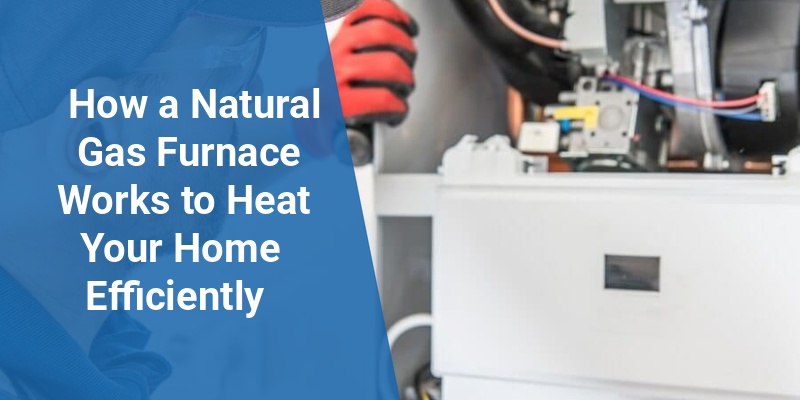A natural gas furnace is a popular heating system found in many American homes, valued for its efficiency and reliability. This appliance burns natural gas to generate heat, which is then distributed throughout the home to maintain a comfortable indoor temperature. Understanding how a natural gas furnace works helps homeowners optimize its performance and ensure safety.
| Component | Function |
|---|---|
| Thermostat | Monitors temperature and signals the furnace to turn on or off |
| Gas Valve | Controls the flow of natural gas to the burners |
| Burners | Ignite the gas to create heat |
| Heat Exchanger | Transfers heat from combustion gases to air without mixing them |
| Blower Fan | Circulates warm air through the ducts into rooms |
| Flue | Exhausts combustion gases safely outside |
Essential Components of a Natural Gas Furnace
A natural gas furnace relies on several key components to function effectively. Each part performs a specific role to ensure the safe production and distribution of heat.
- Thermostat: The device sets and maintains desired home temperature.
- Gas Valve: Regulates gas flow, opening only when heating is needed.
- Burners: Ignite gas to produce flames generating heat energy.
- Heat Exchanger: A metal chamber that absorbs heat from combustion.
- Blower Fan: Pushes heated air through ductwork to rooms.
- Flue or Vent Pipe: Safely removes combustion byproducts outdoors.
The Heating Process Explained Step-by-Step
The operation of a natural gas furnace consists of a series of coordinated steps, ensuring efficient and safe warming of indoor spaces.
1. Thermostat Signals the Furnace
When the indoor temperature drops below the thermostat setting, it sends an electric signal to initiate the heating cycle.
2. Gas Valve Opens
The gas valve receives the signal and opens to allow natural gas to enter the burners.
3. Ignition of Burners
A pilot light or electronic ignition system ignites the gas at the burners, creating hot flames.
4. Heat Exchanger Warms Up
The flames heat up the metal heat exchanger, while combustion gases remain separate.
Call 888-906-9139 for Free Local HVAC Quotes – No Obligation, Just Savings!
5. Air is Heated and Circulated
The blower fan activates, pulling cool air across the warm heat exchanger and distributing heated air through the home via ductwork.
6. Exhaust Gases Vent Outside
Combustion gases travel through the flue and are vented safely outdoors, preventing harmful fumes inside the home.
Safety Features That Protect Your Home
Modern natural gas furnaces include numerous safety mechanisms to prevent accidents and ensure proper operation.
- Flame Sensor: Verifies that burners are lit; if not, it shuts off the gas supply.
- Limit Switch: Prevents overheating by shutting down the furnace if temperatures rise excessively.
- Pressure Switch: Detects proper venting and air pressure to ensure safe flue operation.
- Carbon Monoxide Detectors: Monitor for dangerous CO levels caused by incomplete combustion.
Benefits of Using a Natural Gas Furnace
Installing a natural gas furnace offers several advantages for homeowners seeking an effective heating solution.
- Cost Efficiency: Natural gas is generally less expensive than electricity or oil, reducing heating bills.
- Reliable Heat: Furnaces provide consistent warmth even in very cold weather.
- Energy Efficiency: Modern high-efficiency models can convert over 90% of fuel into heat.
- Environmentally Friendly: Burns cleaner than many fossil fuels, producing fewer emissions.
Maintaining Your Natural Gas Furnace for Optimal Performance
Regular maintenance ensures the furnace operates safely and efficiently, extending its lifespan.
- Annual Inspection: Professional servicing to check components and clean burners.
- Filter Replacement: Changing air filters monthly or quarterly to improve airflow.
- Inspect Venting System: Ensure flue pipes are clear and undamaged.
- Thermostat Calibration: Verify accuracy to prevent energy waste.
Common Issues and Troubleshooting Tips
Despite their reliability, natural gas furnaces can encounter problems that affect heating performance.
- No Heat or Inadequate Heat: Could be caused by thermostat issues, closed gas valve, or dirty burners.
- Frequent Cycling: Short on-off cycles may indicate airflow restriction or thermostat problems.
- Unusual Noises: Rattling or banging can suggest loose parts or blower issues.
- Yellow Pilot Light: Indicates incomplete combustion and possible carbon monoxide risk.
Comparing Natural Gas Furnaces with Other Heating Systems
| Heating System | Fuel Type | Efficiency | Installation Cost | Environmental Impact |
|---|---|---|---|---|
| Natural Gas Furnace | Natural Gas | 80%-98% AFUE | Moderate | Lower emissions than oil or coal |
| Electric Furnace | Electricity | 95%-100% | Lower | Depends on electricity source |
| Oil Furnace | Heating Oil | 80%-90% | High | Higher emissions, oil spills risk |
| Heat Pump | Electricity | 200%-300% (COP) | High | Efficient and clean if electricity is green |
Environmental and Cost Considerations for Natural Gas Furnaces
Natural gas furnaces offer a balance of affordability and environmental impact. While burning natural gas releases carbon dioxide, it does so in smaller amounts compared to other fossil fuels. Homeowners should consider the fuel source, local utility rates, and available incentives for high-efficiency models.
Call 888-906-9139 for Free Local HVAC Quotes – No Obligation, Just Savings!
Implementing smart thermostats and regular furnace tune-ups can boost savings and reduce environmental footprint.
